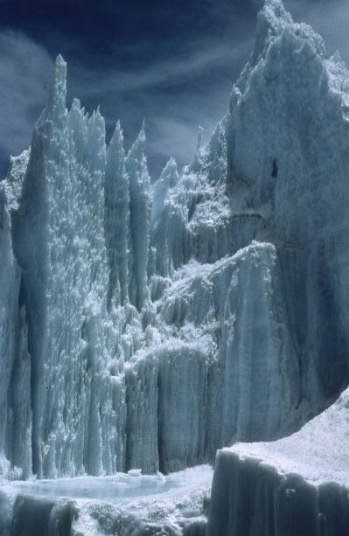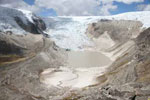The most recent survey among the ice fields atop Mount Kilimanjaro found that the ice atop Africa’s most famous mountain could be gone in twenty years—and maybe even sooner.
Published in the Proceedings of the National Academy of Science the study was conducted by a team of researchers who first measured the glaciers in 2000. They discovered that between 1912 and 2007, 85 percent of the ice that covered Mount Kilimanjaro vanished. When using 2000 as baseline the mountain has lost 26 percent of its ice.
These findings are unique in the last 11,700 years: an ice core going back nearly twelve millennia found no evidence of sustained melting until contemporary times. Even a 300-year-long drought 4,200 years ago, which left Mount Kilimanjaro blanketed in 1-inch thick dust, did not lead to any melting.
 This is one of a growing number of isolated remnants of ice spires that were once full glaciers in the crater of Mount Kilimanjaro in Africa. Photo by: Lonnie Thompson, Ohio State University. |
Perhaps most surprising was the discovery that the loss of ice by thinning is now almost equal to the loss of ice by shrinking.
“This is the first time researchers have calculated the volume of ice lost from the mountain’s ice fields,” said Paleoclimatologist Lonnie Thompson, a research scientist with Ohio State’s Byrd Polar Research Center. “If you look at the percentage of volume lost since 2000 versus the percentage of area lost as the ice fields shrink, the numbers are very close.”
Furtwängler Glacier atop the mountain has melted 50 percent from 2000 to 2009.
“It has lost half of its thickness,” Thompson explained. “In the future, there will be a year when Furtwängler is present and by the next year, it will have disappeared . The whole thing will be gone!”
While cloudiness and changes in precipitation could be playing a role in the melting, it was relatively minor compared to that of rising temperatures, according to the study. The scientists believe that their findings—along with studies of other African glaciers and tropical glaciers melting worldwide—are dramatic evidence of climate change.
 Along with retreat of Kilimanjaro’s glaciers at their margins, the surface of these massive ice fields have begun eroding as temperatures rise. Photo by: Lonnie Thompson, Ohio State University. |
“The fact that so many glaciers throughout the tropics and subtropics are showing similar responses suggests an underlying common cause. The increase of Earth’s near surface temperatures, coupled with even greater increases in the mid- to upper-tropical troposphere, as documented in recent decades, would at least partially explain the observed widespread similarity in glacier behavior,” Thompson said.
Mount Kilimanjaro is both Tanzania’s and Africa’s tallest mountain rising 5,895 meters (19,336 feet) in the air. Since it rises largely from the African plains, it is the tallest free-standing mountain in the world.
One of Ernest Hemingway’s most famous stories is entitled “The Snows of Kilimanjaro”.
Related articles
Glaciers decline in ice mass for 18th straight year
(01/30/2009) Glaciers worldwide lost ice mass for the 18th consecutive year due to warming temperatures and reduce snowfall, reports the University of Zurich’s World Glacier Monitoring Service. Alpine glaciers lost on average 1.3 meters of thickness in 2006 and 0.7 meters in 2007, extending an 11.3-meter (36-foot) retreat since 1980.
99% of Alaska’s large glaciers are retreating
(10/07/2008) The bulk of glaciers in every mountain range and island group in Alaska are retreating, thinning, or stagnating, according to a new book by the U.S. Geological Survey (USGS).
NASA images reveal two massive glaciers breaking apart in Greenland
(08/22/2008) Two of Greenland’s largest glaciers are breaking up report researchers monitoring NASA satellite images.
Lack of A-bomb signatures suggest 50 years of shrinking Tibetan glaciers
(12/30/2007) Ice cores drilled last year from the summit of a Himalayan ice field lack the distinctive radioactive signals that mark virtually every other ice core retrieved worldwide. That missing radioactivity, originating as fallout from atmospheric nuclear tests during the 1950s and 1960s, routinely provides researchers with a benchmark against which they can gauge how much new ice has accumulated on a glacier or ice field.
Glaciers in western China shrank 20% in 40 years
(07/13/2007) Glaciers in Western China have melted at “alarming” rates over the past 40 years, according to Chinese state media.
Glaciers speed up due to global warming
(06/05/2007) Antarctic glaciers are moving faster due to global warming, reports the British Antarctic Survey.
Largest tropical glacier retreating at 200 feet per year in Peru

(02/18/2007) Peru’s largest glacier is melting rapidly and could complete disappear by 2012 says a glaciologist from Ohio State University. Speaking at the annual meeting of the American Association for the Advancement of Science in San Francisco last week, Dr. Lonnie Thompson said that Peru’s Qori Kalis glacier is melting at a rate of some 60 meters (200 feet) per year. Qori Kalis glacier is part of the Quelccaya Ice Cap, the largest body of ice in the tropics.
Why some Himalayan glacies aren’t melting due to climate change
(08/25/2006) New research into climate change in the Western Himalaya and the surrounding Karakoram and Hindu Kush mountains could explain why many glaciers there are growing and not melting. The findings suggest this area, known as the Upper Indus Basin, could be reacting differently to global warming, the phenomenon blamed for causing glaciers in the Eastern Himalaya, Nepal and India, to melt and shrink.
Alps could lose 80% of glacier cover by 2100
(07/10/2006) The European Alps could lose 80 percent of their glacier cover by the year 2100, if summer air temperatures increase by three degrees Celsius according to a study published in Geophysical Research Letters, a journal of the American Geophysical Union. The research, based on modeling experiments by Swiss scientists, found that should in summer temperature rise more than three degree Celsius, only the largest glaciers and those on the highest mountain peaks could survive into next century.
Last 50 years ‘unusually warm’, tropical glaciers melting rapidly finds research
(06/27/2006) Researchers studying ancient tropical ice cores have found evidence of two abrupt climate shifts — one 5000 years ago and one currently underway. The findings, published in the current issue of the journal Proceedings of the National Academy of Science, may have important implications for immediate future since more than two-thirds of the world’s population resides in the tropics.
Africa’s glaciers gone by 2025
(05/15/2006) Fabled equatorial icecaps will disappear within two decades, because of global warming, a study British and Ugandan scientists has found. In a paper to be published 17 May in Geophysical Research Letters, they report results from the first survey in a decade of glaciers in the Rwenzori Mountains of East Africa. An increase in air temperature over the last four decades has contributed to a substantial reduction in glacial cover, they say.